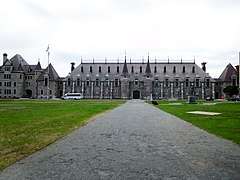Quebec City Armoury
The Voltigeurs de Québec Armoury, formerly Grande-Allée Armoury (French: Manège militaire Grande-Allée, or simply Manège militaire), was built as a Gothic Revival drill hall for the infantry regiment Les Voltigeurs de Québec at 805 Wilfrid-Laurier Avenue East, Quebec City, Canada. Designed by architect Eugène-Étienne Taché and constructed between 1885 and 1888,[3] it is a National Historic Site.
| Grande Allée Drill Hall, Voltigeurs de Québec Armoury | |
|---|---|
 The Armoury in 2018, after its reconstruction | |

| |
| General information | |
| Type | Drill Hall / armoury |
| Architectural style | Gothic Revival Chateau-style |
| Location | Quebec City, Quebec, Canada |
| Address | 805 Wilfrid-Laurier Avenue East |
| Construction started | 1885 |
| Completed | 1888 |
| Renovated | 2018 (rebuilt) |
| Destroyed | 2008 (fire) |
| Owner | Canadian Forces |
| Design and construction | |
| Architect | Eugène-Étienne Taché |
| Awards and prizes | National Historic Site; national Register of Historic Places;[1] Classified - 1987 Register of the Government of Canada Heritage Buildings [2] |
Partially destroyed by fire in 2008, the armoury was then rebuilt and reopened on May 2018.[4]

History
In the Canadian Forces, an armoury is a place where a reserve unit trains, meets, and parades.

"JE ME SOUVIENS" (1989) by André Gauthier, a 6’ X 9’ bronze 'haut-relief' bronze and granite wall memorial, was erected at Place George V in front of the armoury. Unveiled on November 11, 1989, the sculpture honours the memory of the soldiers from the Royal 22e Régiment (R 22e R) or Van Doos French Canadian regiment who were killed during the First and Second World Wars and the Korean War. The sculpture was inspired by A.T.C. Bastiens' painting "L'Avance" at the Canadian War Museum. The names of soldiers are inscribed in granite on the monument.[5]
Fire

The Voltigeurs de Québec Armoury was destroyed by a fire on April 4, 2008. All but a rear wall and turrets beside the front door were burned.[6] Les Voltigeurs de Québec Museum in the amoury which housed various artifacts from the regiment was also lost in the fire. However, officials estimate that 90 percent of the artifacts were saved due to the efforts of members of the regiment and local firefighters.[7] The armoury was to have been one of the venues for the celebration of Quebec's 400th birthday.[8] The armoury's wooden roof was one of the largest of its kind in Canada.[9]
Calls have been made by politicians to rebuild the armoury,[10] to which the federal government has responded positively by allocating $2 million for reconstruction planning.[11] In the fall of 2008, the regimental association launched a lawsuit against the Department of National Defence, blaming negligence on the part of the federal government for the blaze.[12] In 2010, Intergovernmental Affairs Minister Josée Verner announced federal plans to rebuild the armoury by 2016.[13]
As of late 2016 the building reconstruction was continuing, with new roof in place.[14] Work was completed by the spring of 2018, and reopened, for use by the public, military, and other government offices.
Plaque
A Historic Sites and Monuments Board of Canada plaque was erected in 1991 to commemorate the Grande Allée Drill Hall and its architectural uniqueness.[15]
The Grande Allée Drill Hall is an impressive example of a drill hall that retains its original parade square. Designed by Eugène-Étienne Taché, a Quebec public servant and architect, the stone building was completed in 1887, with an addition in 1913. The steeply pitched gable roof, conical towers and fanciful decorative details of the drill hall make it an early example of the French-inspired Château style. The use of the style here is unique among Canadian drill halls of this period and reflects the late 19th century interest in the historic French roots of the city.[15]
 The Band of the Royal Canadian Mounted Police playing in Quebec City
The Band of the Royal Canadian Mounted Police playing in Quebec City- Sculpture at The Quebec City Armoury
- Bas Relief by André Gauthier (sculptor) at The Quebec City Armoury
- Monument at The Quebec City Armoury
See also
References
- "Archived copy". Archived from the original on March 5, 2016. Retrieved June 16, 2016.CS1 maint: archived copy as title (link) Canada's Register of Historic Places
- http://www.pc.gc.ca/apps/beefp-fhbro/FHB_RES_E.asp%5B%5D Heritage Buildings
- Manège militaire Voltigeurs du Québec aujourd'hui Archived April 11, 2008, at the Wayback Machine
- Prime Minister Justin Trudeau takes part in reopening of Quebec City armoury, CTV News, May 12, 2018
- "Royal 22nd Regiment World Wars and Korean War memorial: Memorial 24051-005 Québec, QC". National Inventory of Canadian Military Memorials. Veterans Affairs Canada. Retrieved 5 January 2017.
- "Fire guts historic Quebec armoury". BBC News. 2008-04-05.
- Quebec regiment salvages history from armoury ruins after fire
- Quebec City armoury destroyed by fire - photos and video | Quebec Chronicle-Telegraph Online
- CTV.ca | Investigation launched after Quebec armoury blaze
- Voltigeurs will rebuild Quebec City Armoury, burned to ground
- "Ottawa pledges help to rebuild Quebec City armoury". CBC News. 2008-04-07.
- "Regiment sues DND for armoury loss," Canwest News Service
- "Quebec City armoury to be rebuilt". CBC News. June 11, 2010.
- http://www.tpsgc-pwgsc.gc.ca/biens-property/manege-armoury/concept-eng.html
- "Grande Allée Drill Hall plaque: Memorial 24041-002 Sainte-Foy, QC". National Inventory of Canadian Military Memorials. Veterans Affairs Canada. Retrieved 5 January 2017.
| Wikimedia Commons has media related to Quebec City Armoury. |